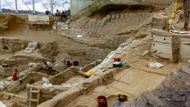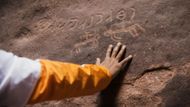A new discovery of the world's oldest known alphabetic writing was made at Tell Umm-el Marra, an urban site in Syria that can be traced back to 2400 BCE. This discovery predates the previously discovered alphabetic scripts by about 500 years and presents a major overturn to the ideas concerning the emergence of writing. These revelations were presented by Glenn Schwartz, a professor at the Johns Hopkins University at the American Society of Overseas Research, at the annual meeting on November 21, 2024.
Excavation details

The text was inscribed on finger-length clay cylinders buried in a tomb at Tell Umm-el Marra which is thought to have been one of the first medium-sized cities in western Syria. This area has always been important, particularly because it was a strategic location for the old trade routes.
The bones of six skeletons were found with gold and silver ornaments, kitchen utensils, iron spearhead, and well-preserved clay vessels. Such artifacts included four lightly baked clay cylinders that contained early alphabetic writings. In fact, the cylinders were all perforated, as if they had been tied to something else, and one of its apparent uses was to act as a label on what was contained in other pots and the ownership or origin of things.
“It changes the entire narrative of how the alphabet was introduced,” Professor Schwartz was quoted by Scientific American.
Characteristics of the writing
The writing is on clay cylinders, each of which is about the thickness of a finger. The identity of the inscriptions' content remains unknown because of the lack of a translation key.
Researchers believe these cylinders could have labeled products like wine or general items and may have described their content or their owner. Professor Schwartz was quoted by Sci News, stating:
“The cylinders were perforated, so I’m imagining a string tethering them to another object to act as a label. Maybe they detail the contents of a vessel, or maybe where the vessel came from, or who it belonged to.”
However, without the option to translate this writing, all of these interpretations come across as purely speculative.
Historical context

As Professor Schwartz pointed out, alphabetic writing changed how communication took place because it was no longer exclusive to royalty and elites. This innovation most probably affected the societal relations in early civilizations.
Until recent findings, the conventional approach provided that the evolution of the alphabet occurred in Egypt at approximately 1900 BCE. Subsequent archaeological and epigraphical discoveries at Tell Umm-el Marra provided the basis for a new narrative of the emergence of alphabetic scripts that challenged earlier historical and socio-political conceptions of how writing came about. Sci News further quoted Professor Schwartz mentioning:
“Previously, scholars thought the alphabet was invented in or around Egypt sometime after 1900 BCE. But our artefacts are older and from a different area on the map, suggesting the alphabet may have an entirely different origin story than we thought.”
Expert insights
Certain scholars who examined a handful of images of the cylinders said they were eagerly anticipating additional data supporting claims that the inscriptions refer to an alphabet and not another type of writing. Philippa Steele, a senior researcher in classics at the University of Cambridge, told Scientific American:
“When you only have a few very short inscriptions, it can be difficult to tell how many signs the system has”.
With so few clues to go on, she said, it's difficult to be certain that the new etchings actually correspond with known Proto-Sinaitic lettering and don't just happen to look like it.
“I think we have to hope for more finds,” she added.
Silvia Ferrara, an early language specialist at the University of Bologna in Italy, told Scientific American:
“It’s an alphabet. It’s easy-peasy. I’m used to much tougher things.”
Professor Christopher Rollston of George Washington University, who teaches biblical and Near Eastern languages and civilizations, told Scientific American:
“The morphology of the letters on the cylinder seals parallels quite nicely that of the existing corpus of early alphabetic writing.”
